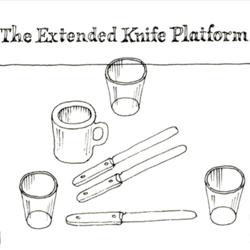Activity
Create an Abstract Dreamscape
In this activity, you will create an art piece inspired by the work of Bernice Bing.
Inspired by Arthur Okamura’s “The Extended Knife Platform.”

“There was a time when kids (and even grown-ups) were able to spend hours using simple items, found in any household, making objects that were silly and fun. Things didn’t need batteries and they were not based on TV characters; they were just things you did together on a kitchen table, or a back porch, but the best part was that there was a bit of mystery in them – they were tricks, and they were wonderful!”
– Arthur Okamura, Paper Propeller, the Jumping Frog, the Spinning Quarter: And 38 Other Amazing Tricks You Can Do With Stuff Lying Around the House
As a magician, Arthur Okamura wrote and illustrated his own magic trick books, including Paper Propeller, the Jumping Frog, the Spinning Quarter: And 38 Other Amazing Tricks You Can Do With Stuff Lying Around the House. In this activity, you will complete one of his physical balance tricks and suspend one cup above or at the same height of three other cups.
Learn More about Arthur Okamura: https://education.asianart.org/resources/arthur-okamura/
You will:
Writing Standards (Grade 4 and 5):
W.5.7: Conduct short research projects that use several sources to build knowledge through investigation of different aspects of a topic. (5-PS1-2),(5-PS1-3),(5-PS1-4)
Science Standards (Grade 4 and 5):
3–5-ETS1-1: Define a simple design problem reflecting a need or a want that includes specified criteria for success and constraints on materials, time, or cost.
3–5-ETS1-2: Generate and compare multiple possible solutions to a problem based on how well each is likely to meet the criteria and constraints of the problem.
3–5-ETS1-3: Plan and carry out fair tests in which variables are controlled and failure points are considered to identify aspects of a model or prototype that can be improved.
5-PS2-1 Support an argument that the gravitational force exerted by Earth on objects is directed down.
Four cups of the same height
Three knives (dull or plastic) or wooden popsicle sticks
Observation Table (under Downloads)
Worksheet (under Downloads)
Other materials to build the final device if desired
Hypothesis: (noun) an educated prediction or explanation that can be tested in an experiment.
Objective: (noun) a goal or end of action.
Evidence: (noun) that which tends to prove or disprove something; ground for belief; proof.
Observation: (noun) the act of gathering information of the outside world through the five senses (sight, sound, smell, touch and taste), or recording information using scientific tools and instruments.